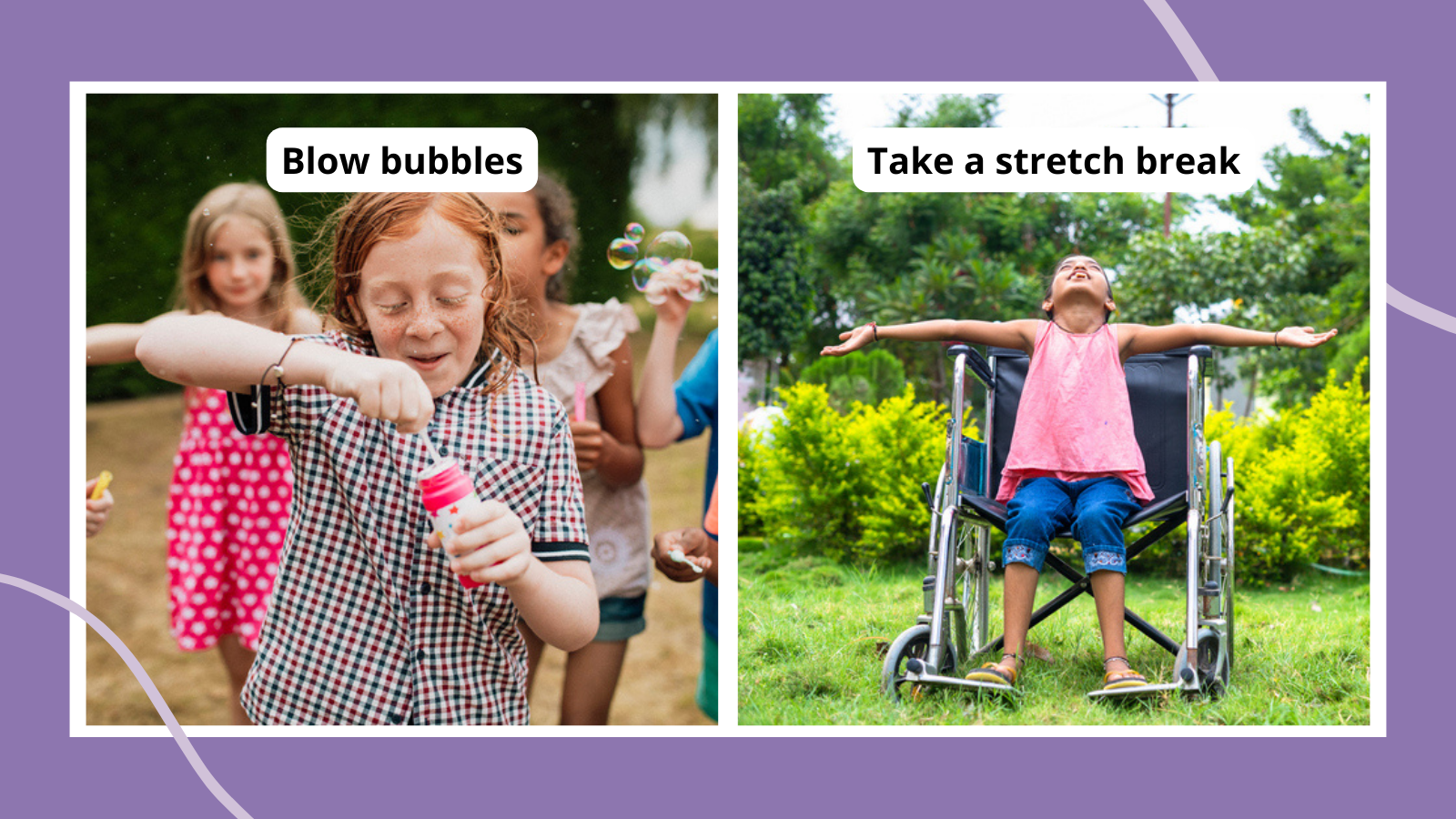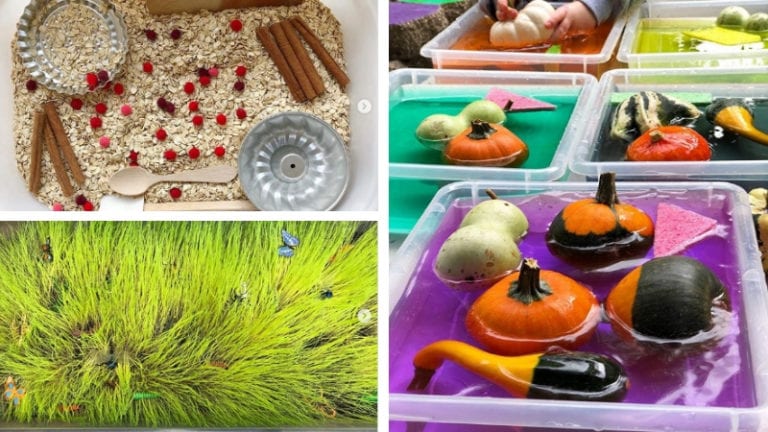Times are tough for kids these days. There are so many issues that are completely out of their control—it really takes a toll on learning. Teaching mindfulness is a great antidote to the stress and anxiety a lot of our kids are feeling. Here are 57 mindfulness activities for kids in preschool through high school to support their well-being.
Mindfulness Activities for Kids in Preschool
1. Fly like an eagle
Combine movement with deep breathing in this exercise. As students walk slowly around the classroom, they breathe in as their wings go up and breathe out as their wings go down. For this and more great ideas, check out 16 Mindfulness Activities for Preschoolers.
2. Play in a sensory bin
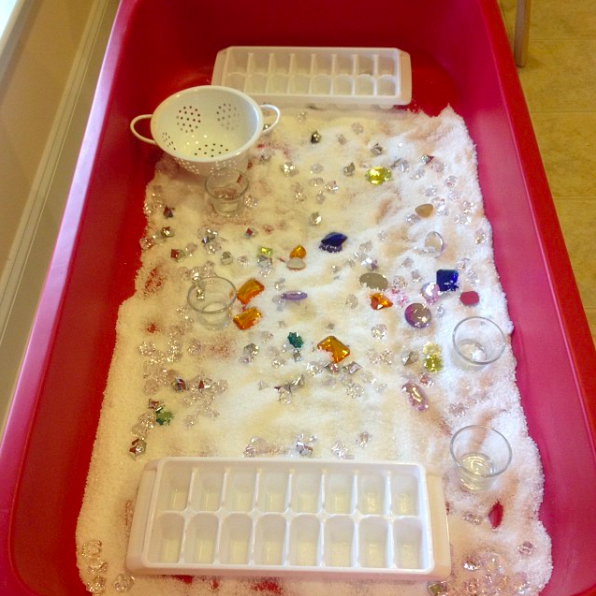
Watch a preschooler at a sensory bin and you’ll see them lost in their own little world. They are the perfect tool to give students time to slow down, think, and wonder. And with so many options to choose from, here are 25 sensory bin ideas to get you started.
3. Bring on the glitter
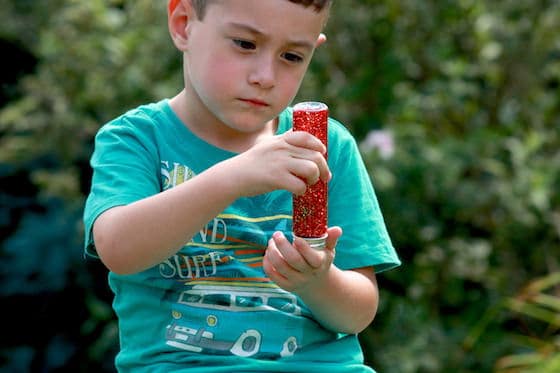
To help kids calm down, have them shake up a glitter jar and then watch and breathe until the glitter settles in the bottom of the jar.
4. Paint nature
Nothing calms kids like connecting with nature. Collect an assortment of leaves, sticks, and rocks, then let kids use poster paint to embellish their finds.
5. Take a golden moment

Sound is a powerful tool in resetting the nervous system. Ask students to sit at their desks, close their eyes, and listen carefully. Ring a chime and ask students to raise their hand when they hear the sound subside.
6. Try teddy breathing

Teach your students how to use slow, mindful breathing. Have them lie down on the floor with a stuffed animal on their chest. Instruct them to breathe in deeply and watch their stuffy rise, then breathe out and watch it fall. See what happens when you breath slower or faster or hold your breath.
7. Read books

There are dozens of brilliant books that teach the lesson of mindfulness for preschoolers. A couple of our favorites, just for little ones, are Peaceful Panda and I Am the Jungle. For more suggestions, try 15 Books To Teach Kids About Mindfulness.
8. Take a listening walk
Teach children to focus and listen carefully as you take them on a listening walk. Inside or out, students can focus on hearing what is around them without interacting. When you return to the room, ask them what they discovered.
9. Or better yet, engage all five senses
Help your students focus on the present moment as you lead them through observing what they see, smell, hear, taste, and feel. For more details, check out this article from Zero to Three.
10. Blow bubbles

Nothing clears the mind (and encourages deep breathing) like good old bubble blowing. Blow bubbles, then watch how far they go before they pop!
11. Get grounded
Do a “mindful feet” body scan with students. Standing (or sitting) with eyes closed and feet firmly planted, ask students to observe how they feel as you lead them through a series of questions. Visit Blissful Kids for more information.
12. Practice finger tracing
Have students sit quietly and put one hand out in front of them, palm facing in. Starting at the base of the thumb, show them how to trace the outline of their hand up around their thumb and around each finger. As they trace upward, ask them to breathe in. As they trace downward, breathe out.
13. Play in water
Water is an age-old remedy for stress and worry. Set up a water table in your classroom and let students rotate through at center time.
14. Dim the lights
Sometimes something as simple as removing one of the many stimuli in the classroom can help students slow down and be present in the moment. Try it next time you have story time, and see if your students are following along with a little presence.
Mindfulness Activities for Kids in Elementary School
15. Use mantras
Mantras are a simple way to encourage positive behavior, help kids focus and relax, and build positive self-esteem. Visit The Daily Meditation for ideas.
16. Breathe deeply
Teach kids to calm their thoughts and bodies with mindful breathing. Ask students to sit quietly at their desks and direct their attention toward you. Have them breathe in as you slowly pull a Hoberman sphere apart until it reaches its full size. As you collapse the sphere, have them breathe out.
17. Listen to your heart
Take a break from classwork and have your students run in place or do jumping jacks for one minute. When the minute is up, ask the students to silently put their hands on their chest and feel their heart beat. Alternatively, teach kids how to detect their pulse. Time them for another minute and ask them to keep track of how many heartbeats they can feel.
18. Create a calm-down corner

Designate a safe and cozy space for students to recenter and refocus. Visit How To Create and Use a Calm-Down Corner for more ideas.
19. Practice mindful art
Taking time to create is one of the best mindfulness activities for kids. Many children find peace and relaxation in art. It focuses their minds and helps them look at the world around them in a much more engaged way. Try a few of these 18 Mindfulness Art Activities.
20. Read stories with a mindfulness theme
Help your students develop their social-emotional awareness with these 15 Books To Teach Kids About Mindfulness.
21. Learn to knit
Not only is knitting a practical craft, it also has wonderful benefits on the body. The rhythm of knitting helps release serotonin, the chemical transmitter that helps regulate anxiety, happiness, and mood. There is a strong connection between knitting and the feelings of calm and happiness in the brain.
22. Try guided imagery
Help students redirect their busy minds with guided imagery. Choose a quiet place that’s free from interruptions. Ask students to sit quietly and close their eyes. Read a guided imagery script slowly as soft, relaxing music plays in the background.
23. Master belly-breathing

Have students lie down, with arms relaxed at their sides and eyes closed. Have them imagine their abdomen is a balloon that inflates as they inhale deeply. As they exhale, they should feel the balloon deflate. Repeat.
24. Just listen
While seated at their desks, have students sit quietly with eyes closed. Ask them to quiet their minds and focus on listening to what’s going on around them. Set a timer for one minute. They may hear birds outside, the hum of the radiator, or the sound of their own breath. Encourage them to keep thoughts from interrupting their listening. When time is up, have them open their eyes. Ask how their minds and bodies feel compared to before the activity.
25. Go on a color search
Give each student a copy of this printable and have them search the classroom (or library, hallway, outdoor space, etc.) to find one item for each color listed on the sheet. The only catch? They must search independently and silently so that everyone can work mindfully.
26. Use drawing prompts
Drawing and doodling are great ways to relax the mind and calm the nerves. In addition to free time for drawing, offer drawing prompts. For instance, “Draw your happy place,” or “Draw your favorite person.”
27. Stretch and refresh

It’s amazing how effective just taking a few moments to silently stretch our bodies is for our energy and attitude.
28. Make time for reflective journaling
Give students time to free-write. Don’t set limits on the content or format of their writing, just encourage them to express themselves any way they choose. They can make lists, write poems or essays or letters they would like to send, or simply jot down words or phrases.
29. Use mindfulness writing prompts
Sometimes kids have a hard time coming up with ideas for what to write about. Offer thought-provoking prompts like “Things that make me happy (or sad or angry)” or “If I had five wishes.” Or have them simply make lists of favorite things (people, animals, games, places). For ideas, check out the We Are Teachers collection of writing prompts
30. Make worry monsters

Teach your students how to make a worry monster. Then, whenever they have something that makes them sad or worried, they can write it down and feed it to their worry monster.
Mindfulness Activities for Kids in Middle School
31. Read storybooks
Think middle schoolers are too old for picture books? Well, think again. Even big kids like to be read to. And many picture books come with excellent mindfulness lessons. Hear one teacher’s story in How I Use Picture Books To Teach Mindfulness in Middle School.
32. Try a little yoga
This engaging class will lead students through warm-up, breathing, and yoga poses, ending with a relaxing power down.
33. Make a happiness collage
Reflecting on what makes us happy helps us develop a feeling of gratitude for our lives. Ask students to bring in photos, drawings, writings, or other mementos that make them happy. Have them glue their items onto a large piece of construction paper and decorate them.
34. Introduce aromatherapy to your classroom
Aromatherapy with essential oils from the flowers, roots, leaves, seeds, bark, or peel of certain plants can help your students be more present and give them a sense of well-being. Best of all, because they are natural substances, they’re completely safe for all ages. Invest in an inexpensive diffuser for your classroom, play around with different scents, and get students’ input on their favorites.
35. Play Mindfulness Bingo
Games can be a useful, shared experience in mindfulness, and who doesn’t love bingo? This colorful bingo game helps students stop and look around their environment to be more present, do something nice for others, and improve their mood.
36. Dig in the garden
One of the best mindfulness activities for kids is connecting with the earth and watching things grow. Why not create a school garden? This would be especially great for city kids, who may not have the opportunity to garden very often. Learn how the experience changed one teacher’s life in How One School Garden Transformed a Neighborhood.
37. Go on a mindfulness scavenger hunt
Take your kids outside and let them wander as they use these cards to learn to focus. Try this scavenger hunt created by the Elkhorn Slough Reserve.
38. Stack rocks
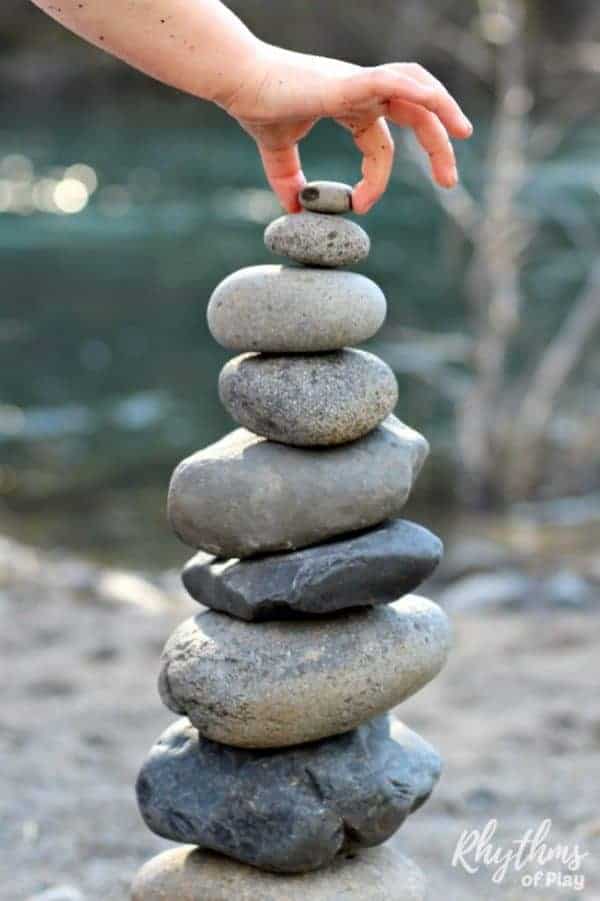
Although the practice of rock stacking in nature is discouraged by some, it can be a great activity to try indoors. Simply buy a supply of stones from your local craft store and let kids build their tower on a square of cardboard.
39. Relax your muscles
Lead your students through a progressive muscle relaxation activity. Try this script from The Behavior Hub.
40. Create self-portraits
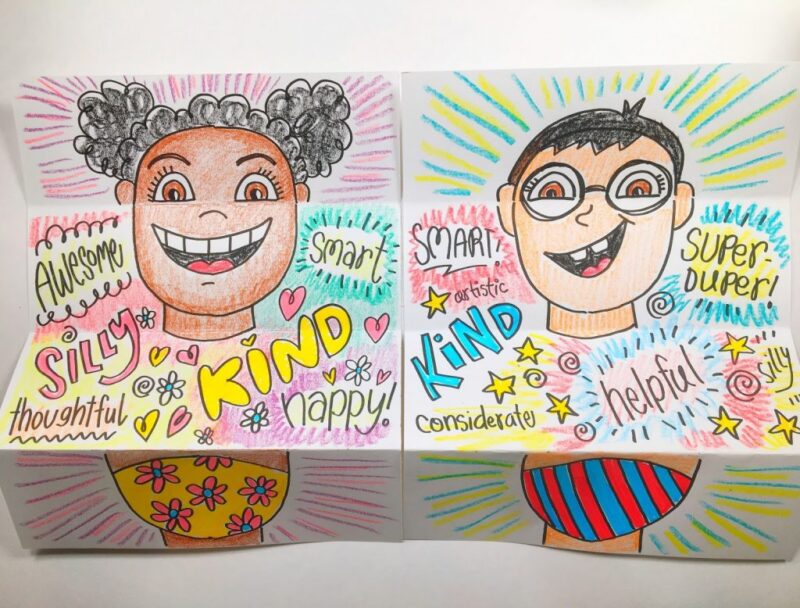
This terrific art project encourages kids to think about what makes them unique. After drawing a portrait, ask them to add words that describe their personality.
41. Set intentions
When kids take time to set a simple intention for their day, it helps them be more productive.
42. Enter peacefully
As students line up to enter your classroom, have each one stop and take a full breath in and out before they come in. This will provide a mindful transition from the chaos of the hallway to a calm learning environment.
43. Practice loving kindness toward yourself

Teach kids to cultivate compassion toward themselves with affirming mantras.
44. Practice loving kindness toward others
Spread a little love to those around you with buddy wishes from Mindful Littles.
Mindfulness Activities for Kids in High School
45. Keep a mindfulness journal
Expressing your thoughts and emotions in a journal is a lifelong strategy that promotes mindfulness. Download this free mindfulness journal to get started.
46. Practice five-finger gratitude
Have students simply take a moment to count out one thing they’re grateful for on each finger. You’ll be surprised how it changes their attitude to one of gratitude. Try this and three other Mindfulness Practices for Your High Schoolers, pus sign up for a free mindfulness course for teachers.
47. Support mindfulness with good books
Check out Be More Yoda: Mindful Thinking From a Galaxy Far Far Away by Christian Blauvelt or The Self-Compassionate Teen by Karen Bluth.
48. Color mandalas

It’s true! Mandala coloring can be therapeutic. And even big kids (and adults) like to color! The activity is known to promote relaxation and foster concentration.
49. Have a lava lamp on hand
We all know the trance-inducing effects of lava lamps. Pick a quiet corner in your classroom for students to retreat to and take a few moments to simply sit and stare. Or better yet, make your own lava lamp!
50. Try 4-7-8 breathing
A simple breathing technique to center yourself and calm your nervous system, the 4-7-8 breathing technique helps to provide a mindful moment through the experience of intentional breathing. To start, first get comfortable. Sit or lie down, then breathe through your nose for four seconds. Hold your breath for seven seconds. Then, breath forcefully out for eight seconds. Try doing multiple cycles of 4-7-8 breathing over the course of a few minutes.
51. Adapt students’ screen time
It’s hard to be mindful when you’re constantly bombarded with input. From tracking screen time to phone-free Fridays, there are many ways to encourage our teens to disconnect from screen time. Learn more with How Schools Are Bringing Commonsense Mindfulness to Screen Time.
52. Try the STOP method
The STOP method is a wonderful grounding exercise from mindfulnessbox that helps students reconnect to themselves. Here’s how it works:
- (S) Stand up and breathe.
- (T) Tune into your body. Notice how it feels and any physical sensations.
- (O) Observe. What is your body telling you?
- (P) Ask what’s possible. What new possibilities might emerge if you’re able to connect with yourself in this moment? How might this be a turning point for the rest of the day?
53. Try dance therapy

Dancing brings important mental health benefits such as stress reduction and symptom relief for anxiety and depression. Read more at Very Well Mind.
54. Download mindfulness apps
There are loads of helpful mindfulness apps to help teens find balance. We like Relax Meditation and Ten Percent Happier. For more, check out the recommendations from Raising Teens Today.
55. Soothe the senses with music
Music has many benefits for the mind. Play classical music during work time in the classroom. Or look up Zen playlists on Spotify to help students focus and create. Here is a list of our favorite classical music for kids.
56. Set daily goals
Starting your day or school period with a positive intention promotes focus and concentration. For more, read about The Power of Setting Intentions—and How To Do It Correctly.
57. Use guided imagery
Ask your students to sit quietly and close their eyes. Then guide them through a mindful visualization in a calm and gentle voice. Try this teen-appropriate script from Compassionate Counseling.
What are your go-to mindfulness activities for kids in the classroom? Come share in our We Are Teachers Helpline group on Facebook.
Also, practice a little self-care with 7 Simple Ways To Sneak Mindfulness Into Your Teaching Day.

